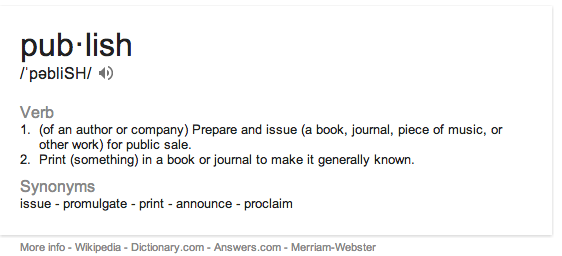Trying to catch up with the ETMOOC recordings and listening in on Dean Shareski’s session on Sharing=Accountability. Much is resonating with me and I am seeing connections to my experience. I think over the past few years I have accepted or found a need and interest in sharing what I learn.
Dean made a point about some re-thinking about the concept of publishing.
“The [Publish] button should be replaced by [Share]”.
I have had a discussion recently about publishing student work on their blogs. Should we publish only ‘perfect, final drafts’ error free or should we allow their first efforts to be seen? It became obvious to me – that we need to re-define [Publishing] and Dean’s [Share] option sits well.
Previously when we published it was our finished product, the result of a writing and editing process. This was necessary and preferred as the printed results were set in stone (all-be-it ink in paper) . Web 2 has altered the way we can go through the editing process, we can now [share] our unfinished thoughts, elicit feedback and constantly edit and re-edit.
Clicking [Publish] does not mean we are finished working, finished thinking but simply exposing our process. Whereas, publishing, once referred to the final process in an exhaustive editing process.
This brings me back to my previous post about why people shy away from blogging. Our expectation that what we publish is perfect. There is a concern amongst teachers of young students that we are weakening the conventions if we allow less than perfect writing to be published, that we are modelling poorly and I can understand that, but I feel that the benefits of exposing our first attempts and our process outweigh this risk. Some re-thinking about how we view what we read on-line, how we evaluate it and what we expect of it may be required. What do you think?

Celia,
I don’t remember using that phrase but from now on I will. 😉
It certainly does help make the distinction between a word that has many connotations that have separated the amateur from the professional and as you state as paralyzed many from entering into a world where those walls and barriers have largely been erased.
That said, I still struggle with ways for us to distinguish those items that need more work with those that have gone through more of a vetting, reworking process. I readily acknowledge the development of personal filters to do much of this work but also look for other clues, symbols and references to help me understand better the context of any given work. With regards to blogging for example, I’ve always wondered if we could use tags and categories better with students to help distinguish, off the cuff “sharing” with more involved “publishing” Certainly that’s not the entire answer but I do value ways to help us differentiate our own work and allow others to more easily understand and then improve upon our ideas and content.
Thank you for this.
Thanks for the comment Dean,
I apologise if I mis-quoted you, this was the message I took. The idea of using tags is excellent, I do not use them well. They have a great deal of potential for classifying content as well as styles etc.
Celia
Hi Celia,
This is a wonderful post and I know you have blogged about this before. It really makes us think about the “old” ways of publishing students work. But with access to the vast range of technologies this truly pushes the boundary of what we mean by publishing. Ideas Lab have said we need to rethink the way we use the term and we need to consider that publishing should be just part of the process of “sharing our thoughts”. We can now just as easily share our thinking about our thoughts as much as we can share our work. Wonderful opportunities ahead!
Dean